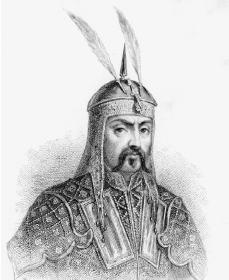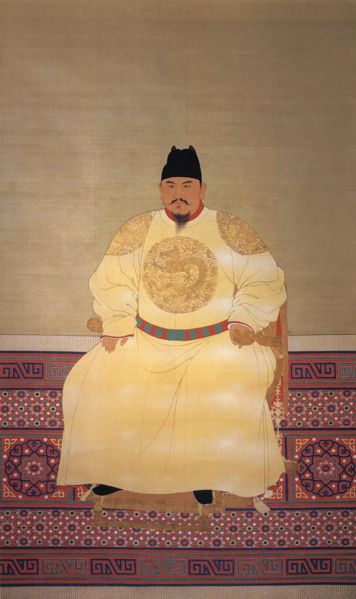I. The Rise of the Mongols, 1200-1260
A. Nomadism in Central and Inner Asia
1. Mongol Society--pastoral nomads of the Eurasian steppes played on on-again, off-again role in Europe, the Middle East, and Chinese history for hundreds of years before the rise of the Mogols. Moving regularly and efficiently with flocks and herds required firm decision-making in public, with many voices being heard
a. Decsions were largely made by a council with representatives of leading families ratifying decisions made by the leader, the khan. Yet people who disagreed with a decision could strike off on their own--even during military campaigns.
b. Menial work in Mongol communities fell to slaves--people either captured during war, or who sought refuge in slavery to escape starvation.
2. Mongol women--leading families combined resources and solidified intergroup alliances through arranged marriages and other acts, a process that helped to generate political federations. Marriages were arranged in childhood and children became pawns of diplomacy. Women from prestigious families could wield power in negotiations and management, although they risked assassination and execution, just like the men.
3. The Khan--families often included believers in two or more religions, most commonly Buddhism, Christianity, or Islam--but virtually all Mongols observed practices of traditional shamanism. Mongols believed in world rulership by a khan who, with the aid of his shamans, could speak to and for an ultimate god, represented as the Sky or Heaven.
B. The Mongol Conquest, 1215-1283--shortly after his acclamation in 1206, Genghis initiated two decades of Mongol aggression. By 1209 he had defeated the Tanggut, and in 1215 he captured the Jin capitol of Beijing. In 1219 he turned westward, invading Khwarezem, east of the Caspian Sea, that included much of Iran. After 1221, when most of Iran had fallen, Genghis left the command of most campaigns to subordinate generals.
1. Genghis Khan's successors--Ögödei, Genghis's son, became the Great Khan in 1227 after his father's death. He completed the destruction of the Tanggut and the Jin and put their territories under Mongol governors. By 1234 he controlled most of northern China and was threatening the Southern Song.
a. 1236 Batu, Genghis's grandson, attacked Russian territories, took control of the towns along the Volga River, and conquered Kievan Russia, Moscow, Poland, and Hungary in a five-year campaign. Only the death of Ögödei in 1241--and the suspension of the campaign--saved Europe from more serious damage.
b. Güjük (another of Genghis's grandsons) was installed as the new Great Khan, and the conquests resumed. In the Middle East a Mongol army sacked Baghdad in 1258 and executed the last Abbasid caliph.
c. Genghis Khan's original objective had probably been collecting tribute from these various conquered peoples, but the success of the Mongol conquests created a new situation. Ögödei unquestionably sought to rule a united empire based at his capitol--Karakorum--and until his death he controlled the subordinate Mongol domains: the Golden Horde in Russia and the Jagadai domains in Central Asia. After Ögödei's death, however, family unity began to unravel; when Khubilai declared himself Great Khan in 1265, the descendents of Genghis's son Jagadai and other branches of the family refused to accept him. As Karakorum was destroyed in the ensuing fighting, Khubilai transferred his court to the old Jin capitol of Beijing. In 1271 he declared himself founder of the Yuan Empire.
d. Jagadai's descendents continued to dominate Central Asia and enjoyed close relations with the region's Turkic-speaking nomads. This, plus a continuing hatred of Khubilai, contributed to Central Asia becoming an independent Mongol center of power and to the spread of Islam there.
e. After the Yuan destroyed the Southern Song in 1279, Mongol troops attacked Annam--now northern Vietnam. They occupied Hanoi three times and then withdrew after arranging for tribute. In 1285 Khubilai's forces invaded Champa--now southern Vietnam--and made it a tribute nation as well. A plan to invade Java by sea failed, as did two invasions of Japan, in 1274 and 1281.
2. Military techniques--the Mongols were extraordinary riders and utilized superior compound bows. These bows could shoot over one-third farther than bows used by their opponents. Mongol archers had only 5 arrows, and rarely used all of these; utilizing their marksmanship from afar, their shots decimated enemy bowmen, and then they charged the opposing infantry on horseback with sword, lance, javelin, and mace.
3. Seige and Terror--cities that resisted faced seige and annihilation--surrender was the only option. The slaughter the Mongols inflicted on Balkh in present-day nothern Afghanistan and other cities that resisted spread terror and caused other cities to surrender.
C. Overland Trade and Disease
1. Travelers' accounts: Marco Polo--the Mongols facilitated trade, and travelers' accounts like Marco Polo, who freely mixed the fantasic with the factual, whetted appetites of other adventurers and traders.
2. Rats and fleas--in northwestern China bubonic plague had festered since the early Tang period. In the mid-13th century, supply trains servicing Mongol garrisons in Yunnan province facilitated the spread of rats carrying infected fleas. Marmots and other rodents along the caravan routes became infected and passed the disease to dogs and humans. Plague incapacitated the Mongol army during its assault on the city of Kaffa in Crimea in 1346. They withdrew, but the plague remained. From Kaffa flea-infested rats reached Europe and Egypt by ship--and began the Black Death.
II. The Mongols and Islam, 1260-1500
A. Mongol Rivalry
1. Il-khan--the state established by Genghis's grandson Hülegü, and controlled Iran, Azerbijan, Mesopotamia, and parts of Armenia
2. Golden Horde--controlled the area north of the Caspian Sea, and had conquered southern Russia and established their capitol at Sarai on the Volga River--and founded by another grandson, Batu.
3. Conversion to Islam--the Golden Horde quickly adopted the Turkic language and Islam, and Batu's successor swore to avenge the killing o fthe Abbasid caliph. Mongol dietary practices (the believe that animals should be consumed with as little bloodshed as possible) were appalling to Muslims (who used the kosher practice of killing animals by draining them of blood by cutting the cartoid artery). While this might seem an insurmountable obstacle, the flexibility of Islam proved able to overcome this difficulty.
4. European allies--this division among the Mongols gave some Europeans hope that the Il-khan state could be recruited to help them regain control of a number of sites in the Holy Land, but the conversion of the Il-khan ruler Ghazan to Islam in 1295 quashed that hope.
B. Islam and the State
1. Taxes and Administration--the Il-khan government sold tax-collecting contracts to small partnerships, mostly consisting of merchants who might also finance caravans, small industries, or military expeditions. Whoever offered to collect the most revenue for the government won the contract. These collectors could use whatever method they chose and could keep everything over and above the contracted amount. While this lowered administrative costs in the short run, in the long term the extortions of the tax farmers drove many landowners into debt and servitude. Agricultural productivity declined, making it hard to supply the army--so the government resorted to taking land to grow its own grain.
2. Paper money--Ghazan faced many economic problems, and citing Islam's humane values, he promised to reduce taxes. But the need for revenue kept the decrease from being permanent, and the government began printing paper money to make up for the shortfall, causing inflation.
3. Khanate of Jagadai--led by Timur (known in the west as Tamerlane), who challenged the control of Il-khan and the Golden Horde from a base in Central Asia.
C. Culture and Science in Islamic Eurasia
1. Administrators and Historians--the Il-khan and Timurids (descendents of Timur) presided over a brilliant cultural flowering in Iran, Afghanistan, and Central Asia based on blending Iranian and Chinese artistic trends and cultural practices. The dominant cultural tendencies were Muslim, however. Timur died before he could unite Iran and China, but by transplanting Middle Eastern scholars, artists, and craftsmen to his capitol Samarkand, he fostered the cultural achievements of this descendents.
III. Mongol Domination of China, 1271-1368
A. The Yuan Empire, 1271-1368--the Yuan sought a fruitful synthesis of the Mongol and Chinese traditions. Khubilai Khan gave his oldest son a Chinese name and had Confucianists participate in the boy's education.
1. Beijing as Yuan Capitol--Beijing served as the eastern terminus of the Silk Road. A horseback courier system improved communications with other parts of the kingdom.
2. Yuan Society--with the Mongol takeover, society in the Yuan Empire was re-ordered, with Mongols at the top, Central Asians and Middle Easterners next, then northern Chinese, and lastly southern Chinese.
3. Yuan Administration--like the Il-khans, the Yuan rulers stressed census-taking and tax collecting--especially tax collecting. The Mongols organized all of China into provinces, and the central appointiments of provincial governors, tax collectors, and garrison commanders marked a radical change. These appointments went almost exlusively to Mongols, Central Asians, and Middle Easteners, shutting out the Chinese.
4. Growth of Commerce--with the Chines shut out of government posts, for which the Confucian system had channeled Chinese elites into, elite families instead began moving into commerce, both as merchants and as bankers, especially lending money to Mongol elites. They also moved into tax farming. While Central Asians and Middle Easterners initiall controlled the corporations in China, Chinese with money quickly became partners, and many eventually gained controlling interests in these corporations.
5. Population loss--although Chinese elites found ways to prosper under Mongol rule, the same could not be said for rural Chinese. Chinese farmers were treated brutally, and many lost their landholdings due to the extreme rate of taxation. Peasant uprisings usually led to even greater brutal treatment.
B. The Fall of the Yuan Empire--in the 1340s, strife broke out among the Mongol princes. Within 20 years, farmer rebellions coupled with this internal political strife created a period of chaos. In this situation, a charismatic Chinese leader, Zhu Yuan-zheng, mounted a campaign that destroyed the Yuan Empire and brought China under the control of his empire, the Ming. Although some Mongols, Central Asians, and Middle Easterners fled the country, a number stayed, assumed Chinese names, and became part of the diverse cultural world of China
IV. The Early Ming Empire, 1368-1500
A. Ming China on a Mongol Foundation--the Ming dynasty re-established many former Chinese practices. The early Ming years was one of conflict over reaching out to the world outside the borders of China, however.
1. Emperor Hongwu--moved the Ming capital to Nanjing on the Yangzi River, turning away from the Mongol capital. Hongwu choked off relations with Central Asia and the Middle East, and severely restricted imports and foreign visitors. Silver replaced paper money for commerce and tax collection, but this proved as economically unhealthy as Yuan policies.
2. Emperor Yongle--seized power in a coup d'etat. Yongle returned the capital to Beijing, and improved the Forbidden City to its current splendor. Yongle also re-established commercial links to the Middle East. Because Mongols still largely controlled the Silk Road, he turned to a possible maritime solution
3. Zheng He--a Muslim enuch, Zheng He was put in charge of this maritime expedition to establish contacts with the Indian Ocean.











I am really surprised by the quality of your constant posts.You really are a genius, I feel blessed to be a regular reader of such a blog Thanks so much..Plz Visit My Blog-
ReplyDeleteOnlinekaj.com
Latest mobile price in bangladesh
চাকরির খবর 2021